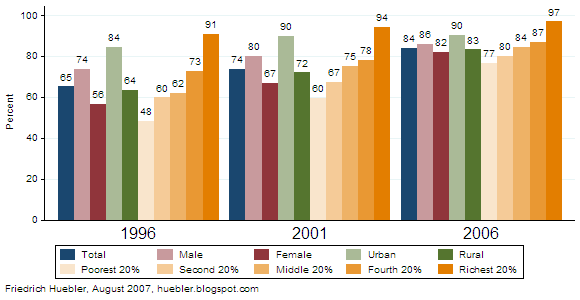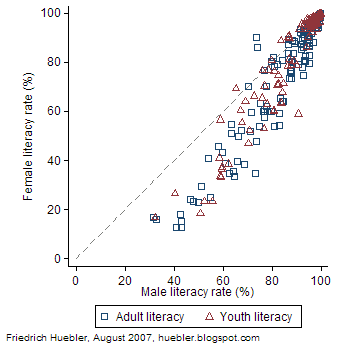The increase in attendance was accompanied by a reduction in disparities between boys and girls, residents of urban and rural areas, and children from different household wealth quintiles (see the graph and table below). Much of the increase in primary school attendance is due to higher attendance rates in rural areas, especially over the period 2001 to 2005, when attendance in urban areas grew only marginally.
Primary school net attendance rate (%), Nepal 1996-2006

Data source: Nepal Demographic and Health Surveys, 1996, 2001, 2006.
Children from the poorest 20 percent of all households saw the biggest increase in primary school attendance, from 48 percent in 1996 to 77 percent 2006. The difference in the primary NAR between children from the richest and poorest household quintiles fell by more than half over the same period, from 42 percent in 1996 to 20 percent in 2006.
Nepal also achieved a marked reduction in gender disparity over the past 10 years. In 1996, only 56 percent of all girls of primary school age attended primary school. This share grew to 82 percent by 2006. The primary NAR of boys grew from 74 percent to 86 percent over the same period. With a gender parity index (GPI) of 0.95 - the ratio of female to male NAR - Nepal has almost reached the Millennium Development Goal of gender parity in primary education.
Primary school net attendance rate (%), Nepal 1996-2006
| 1996 | 2001 | 2006 | Change 1996 to 2006 | |
| Total | 65.1 | 73.5 | 84.1 | 19.0 |
| Male | 73.6 | 79.9 | 86.0 | 12.3 |
| Female | 56.4 | 66.8 | 82.0 | 25.6 |
| Urban | 84.3 | 89.8 | 90.2 | 5.9 |
| Rural | 63.6 | 72.0 | 83.2 | 19.6 |
| Poorest 20% | 48.4 | 59.6 | 76.7 | 28.3 |
| Second 20% | 59.7 | 67.4 | 79.8 | 20.1 |
| Middle 20% | 62.0 | 75.1 | 84.3 | 22.3 |
| Fourth 20% | 72.6 | 78.2 | 86.9 | 14.3 |
| Richest 20% | 90.6 | 94.3 | 96.9 | 6.2 |
Comments on the 2006 DHS data
The authors of the final survey report from the 2006 DHS in Nepal counted children in school-based pre-primary centers as primary school students for the calculation of the primary school NAR. Children in informal, community based preschool classes were excluded from the calculation of the primary NAR. The author of this article chose the same approach.
A UNESCO country profile of Nepal prepared for the Education for All Global Monitoring Report 2007 explains that "there are significant differences in the way the school based and the community based [early childhood development centres] are running. Most of the school based centres are run by the DEO [District Education Office], and most of them are more primary schools than development centres."
The statement by UNESCO supports the treatment of children in school-based pre-primary centers in Nepal as equivalent to children in primary school for statistical purposes. In developing countries it is not uncommon to find children of primary school age in preschool but because of national differences the interpretation of the data from Nepal cannot necessarily be applied to other countries.
Related articles
- Secondary school attendance in Nepal, 1996-2006
- Primary and secondary school attendance in Nepal
- Nepal: trends in primary education, 1980-2004
- Caste, ethnicity, and school attendance in Nepal
- Education disparity in South Asia
- Education for All Global Monitoring Report 2007
- United Nations Millennium Development Goals
- Demographic and Health Surveys (DHS)
- Nepal: Early childhood care and education (ECCE) programmes, UNESCO 2006 (PDF, 56 KB)
- Nepal Demographic and Health Survey 2006, final report (PDF, 4.95 MB)
Permanent URL: http://huebler.blogspot.com/2007/08/primary-school-attendance-in-nepal-1996.html
